The body as the site of human agency is a text
that is as problematic as it is tangible for postmodernist thinkers and
for those who would go to war. Hence, the body as the site of agency must
be armored so that it can better carry out the will, which is guided by
cognitive ability. One way to transcend the limitations of the flesh and
to therefore enhance human agency is to augment the capabilities of the
human body with machines. This synthesis of the human and the automaton
is the cyborg, a construct that is reified as empowering by both postmodernists
and weapons designers alike. The machine would be engineered so that it
conformed to the human being. But in this melding of the engine to the
human, in this coalescing the automation to the brain, the cyborg makes
the site of the engineered human as one that is fraught with trouble, subverting
the intentions of its creators.
Now, human beings have always manipulated the material world to augment
the organic abilities of the body. The horse was domesticated to carry
burdens, writing was invented to augment human memory, and fire harnessed
to extend daylight hours and prepare food. But in all these inventions,
the human being is physically distinct and distinguishable from the invention
he or she manipulates. It seems to follow that the machine would be even
more useful to its human wielders if it were shaped and designed to work
seamlessly with the body of its inventors.
This fusion of human and instrument, the cyborg, opens new possibilities
for those restricted by the confines of flesh. It is a construct that,
because of its melding of the biological with the mechanical, brings the
machinic complement 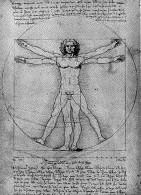 from
the level of mere tool the level of the prosthetic, a device whose relationship
to the human being it supports is no longer one of mere expediency, but
of symbiosis. This synthesis makes possible human abilities on a level
not restricted to the organic body, and in this enhancement of agency,
function more efficiently in war. Engineering becomes the rational placement
and ffers the possibility of transcendence of the constraints imposed by
the merely biological. The cyborg therefore holds promise for not only
postmodern thinkers, but designers of military weapons technology as well,
both of whom seek release from the constraints that the body imposes on
human agency. from
the level of mere tool the level of the prosthetic, a device whose relationship
to the human being it supports is no longer one of mere expediency, but
of symbiosis. This synthesis makes possible human abilities on a level
not restricted to the organic body, and in this enhancement of agency,
function more efficiently in war. Engineering becomes the rational placement
and ffers the possibility of transcendence of the constraints imposed by
the merely biological. The cyborg therefore holds promise for not only
postmodern thinkers, but designers of military weapons technology as well,
both of whom seek release from the constraints that the body imposes on
human agency.
The Body
The disparity between the notions of agency in
postmodern theory and weapons design are just that in many ways: apparent.
Within the two discourses run common assumptions about the nature of technology,
the relationship of the machinic element of the cyborg to its biological
complement, and that the use of technology enhances agency, and how technology
does that enhancement, many of which are portray the relationship between
the human being as symbiotic and benign. In a deeper interrogation of these
assumptions, the cyborg will show itself to be a creature that, in its
uncertain genesis, subverts and defies the intentions of those who would
appropriate the promise of its uncanny origins. The prefix of cyber in
the term cybernetic organism finds its origins in the Greek work kyber,
or steersman, indicating that the machinic component leads the organic
one. It is through the 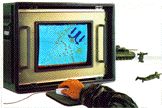 interrogation
of the military text of the main battle tank that the kyber, the steersman,
will return to its etymological meaning. interrogation
of the military text of the main battle tank that the kyber, the steersman,
will return to its etymological meaning.
In order to understand how the cyborg affect the notion of human agency
in war, we must ask, what is the end of human agency in war? The end of
human agency in war is not human agency in and of itself, but agency in
the form of will that the soldier applies to the battlefield in order to
attain the objectives of the battle. Those objectives, for the most part,
are not set by the soldier himself, but by the commanders to whom the soldier
is subordinated. The objectives are decided upon through the use of reason.
This contradicts the popular notion of war, which
holds that the essence of war is chaos and dissolution. Although these
elements are also always present on the battlefield, they are primarily
associated with the individual experience of war, the experience of the
soldier. There are, however, may levels at which one can experience war.
They differ in the contact one has with direct fire, the manner in which
one interacts with one's machinic complement, and the manner in which one
uses reason and agency. Generally, the further one is removed from direct
fire, the broader one's perspective is on the actions in a given battle.
Let us call the perspective that is commonly associated with war the soldier
level, while above that level there is the command level. At both of these
levels, technology is seen to be an inert object that has meaning only
in relation to the soldier that is using it, and therefore is incapable
of affecting human behavior and existence except through the intervention
of human agency. Technology is seen to exist in order to benefit the soldier
by augmenting his organic capabilities, thereby enhancing the soldier's
agency and hence his ability to impose his will on the battlefield. Since
technology was developed for the soldier's benefit, and since it is theorized
in terms of human capability, the machine is understood as being subordinated
to the will of the human that wields it.
The Soldier

The Level of Command
The above generalizations are rather crude, but suffice
to demonstrate that at every level of war, humans use machines, whether
they be rifles or simulations technology, to enhance their ability to make
decisions on the battlefield and implement those decisions. Because the
decisions made at every level of war literally involve life and death,
the interaction of man and machine is at its most compelling and complete
synthesis in the activity of war. Inherent in this discourse is the relationship
that Donna Haraway posits for the cyborg: that the human being, in using
the machine for the enhancement of agency, can maintain a boundary between
his own identity and that of the machine and that the machine is subordinated
to human intentions. Also inherent in this discourse is the assumption
that to increase the ability to use reason is to increase human agency.
One way to give agency to soldiers on the battlefield is to give them technology
that is more accurate, more powerful and more efficient. The main battle
tank is the machinic component of the cyborg that was developed in response
to the need to increase individual soldier agency on the battlefield.
The
Main BattleTank

The tank and its crew members work in concert
with three fundamentals of Army operations that the tank embodies; firepower,
mobility, and crew protection. But the tank also embodies the agency possible
through vision.
Firepower
Mobility
Crew Protection
Vision
In the main battle tank and its crew we find the
material expression of each of three essential elements of war. The first
of these is the preservation of the boundary between enemy and friendly
through the material enforcement of the principle of noncontradiction.
 It
is preservation of boundaries, not establishment, because the act of war
presupposes irreconcilable differences between two forces or countries.
At the soldier level, the cyborg of the tank ensures the boundary not only
through the armor protection it imposes over the crew, but through the
distinctive designs of vehicles of different national armies. It therefore
preserves the individuality of the soldier as a living, functional human
being, not an enemy that momentarily faces dissolution. The tank also expresses
the sovereignty of the country it fights for as distinct from that of the
enemy. This principle of noncontradiction, the reification of division,
is one that warring armies struggle to maintain at all costs. The dissolution
of these boundaries is called, at the soldier level, death. At the national
level, it is peace - or surrender. It
is preservation of boundaries, not establishment, because the act of war
presupposes irreconcilable differences between two forces or countries.
At the soldier level, the cyborg of the tank ensures the boundary not only
through the armor protection it imposes over the crew, but through the
distinctive designs of vehicles of different national armies. It therefore
preserves the individuality of the soldier as a living, functional human
being, not an enemy that momentarily faces dissolution. The tank also expresses
the sovereignty of the country it fights for as distinct from that of the
enemy. This principle of noncontradiction, the reification of division,
is one that warring armies struggle to maintain at all costs. The dissolution
of these boundaries is called, at the soldier level, death. At the national
level, it is peace - or surrender.
The warring assemblage of human and machine not only reifies the boundary
through the enforcement of the principle of noncontradiction, it does so
through distinctiveness of war machines, the disciplined use of sophisticated
fire control systems, and rigorous training of the human gunner, who must
first identify the target as enemy before destroying it. Rather than allow
this cyborg to wander the battlefield alone, reason provides the further
territorialization of the firepower and mobility through the use of sophisticated
communications devices that lock the tank into the framework of a military
unit that is focused on an objective.
Modern warfare is one of the most technologically sophisticated environments
in which man operates today, and in order for him to retain his presence,
both in the world at large and on the battlefield, he must become a cyborg,
becoming reconfigured in technological terms in order to operate in this
technological space6. The peril of such a merging is that by becoming a
cyborg, man risks losing his definition as a subject, for, "[t]o let
go of the flesh is to surrender the subject" (Bukatman 258). However,
if man makes the choice to bond with the machine, he exercises agency and
therefore is empowered by this choice. By making the choice to fuse with
the machine, man is armored against it.
The notion of the Harawaian cyborg also maintains a boundary between human
and machine in a sense, since Haraway says that we as humans can be responsible
for the boundary, we can be responsible for the machine. In this distinction
between human consciousness and the machinic appendage, this construct
implicitly assumes that the machine is a substance upon which one can impose
one's will, one's agency and implicitly one's identity as a postmodern
subject. One is still a site separate from the machine. By being surrounded
by the machine, one can resist the structures and modes of representation,
the dualities of other/same, one can shatter the construct of the mirror
and eye and breached the chains that bind master and slave. But even reason
itself cannot operate effectively in the face of the ultimate dissolution
of  human
death. And so the cyborg of the tank physically armors the identity of
its crew, surrounding it in sophisticated alloys and ceramics that deflect
enemy missiles, augmenting, transcending, and ultimately replacing the
organic human capabilities of the striking fist, the running leg, the shielding
womb, and the targeting eye, and making these supermagnified functions
not just tools of the soldiers that man the machine, but organic implementations
of reason in the face of death. In military culture, the tank is not a
shield to cower behind: it is not a defensive weapon. It and fortifies
the solider as an individual, armoring his identity and magnifying his
agency in the face of violence. A unit of tanks gives a commander a potent
weapon on the battlefield that permits him to force the enemy to submit
to the commander's will at the time and place of his own choosing, allowing
him to engineer the battlefield to his vision. human
death. And so the cyborg of the tank physically armors the identity of
its crew, surrounding it in sophisticated alloys and ceramics that deflect
enemy missiles, augmenting, transcending, and ultimately replacing the
organic human capabilities of the striking fist, the running leg, the shielding
womb, and the targeting eye, and making these supermagnified functions
not just tools of the soldiers that man the machine, but organic implementations
of reason in the face of death. In military culture, the tank is not a
shield to cower behind: it is not a defensive weapon. It and fortifies
the solider as an individual, armoring his identity and magnifying his
agency in the face of violence. A unit of tanks gives a commander a potent
weapon on the battlefield that permits him to force the enemy to submit
to the commander's will at the time and place of his own choosing, allowing
him to engineer the battlefield to his vision.
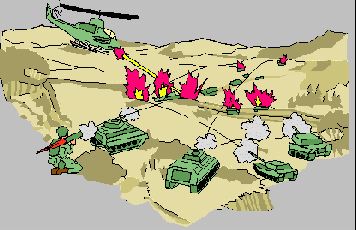
There is this science called human
engineering, the common understanding of which is to design the machine
to work in concert with the human, so that it will respond to human will
efficiently. It places the human being in the position of privilege in
relation to his machinic complement. Commonly called ergonomics, this discipline
is often associated with designing a machine to comfortably conform to
and accommodate the physical human form in an effort to ensure operator
comfort and reduce fatigue. But if one takes the term to mean literally
changing something, be it an object or a system, to be compatible with
what is truly human in the human, then the comfort aspect of human engineering
misses the definition. In the traditional Cartesian body/mind dualism of
the human being, the body equals nature and the mind equals culture8. Therefore,
to truly engineer something to the human being is to engineer it to fit
the norms of his culture and his way of thinking. In the army, that means
to engineer the tank to more closely fit the demands the culture of war
demand, to make it as precise, powerful and invulnerable a machine as possible
so that it may be the keen tool of the agency of the tank crew and of the
commander, whether he be tactical or strategic.
Now, the use and construction of tools is often considered the hallmark
of human culture.  The
use of tools implies the use of the body. This means that the initial definition
of human engineering, in which an object is adapted for more comfortable
use by human bodies, is not incorrect. It also means that, since the use
of tools implies manipulation of the environment both in order to create
and wield tools, that in a sense engineering has always already been part
of the definition of what it is to be human. The
use of tools implies the use of the body. This means that the initial definition
of human engineering, in which an object is adapted for more comfortable
use by human bodies, is not incorrect. It also means that, since the use
of tools implies manipulation of the environment both in order to create
and wield tools, that in a sense engineering has always already been part
of the definition of what it is to be human.
But to truly engineer something to fit the human, it must be engineered
to fit those aspects of the human being that are truly human, culture and
the mind, which is the seat of rationality. Therefore, a second definition
of human engineering is to make something conform to the standards of human
rationality. And in order to make an object conform to a given standard,
, one must have a clear vision of what that standard is and how that object
will be shaped to fit that standard. Weapons technology is therefore developed
in response to the needs of the current warfighters, in response to how
the commander wants to make the battlefield evolve according to his own
vision.
Engineering implies vision, and the desire to see something conform to
that vision. If sadism is also about desire and pleasure in vision, in
visualizing, then in a sense engineering is a form of sadism9. And if in
a sense humans are always already engineers, then we are already sadists,
viewing and engineering the world around us into the spectacle that we
want to view. This is in fact the case with commanders on the battlefield,
whose staffs undergo hundreds of hours to prepare plans to make the battlefield
conform to his view. However, this work is the world of abstract thought.
In material discourse, the battlefield is shaped by the implementation
of the tank. The tank is therefore not only shaped by the force of human
engineering, but is a tool of human engineering itself.
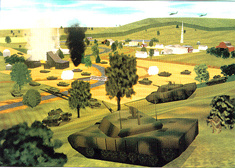
Therefore the human takes an object he see as
nonrational, as not conforming to his vision, and submits it to his version
of what is rational. In this manipulation of the environment, he expresses
the highest form of human knowledge, which is not introspection and acceptance,
but rational control. But he submits this object to this engineering gaze
to make it suit his violent expression of the rational more closely, and
thereby to improve both it and himself.
Some things, however, resist such attempts at rational improvement. One
of these things is the body itself, especially that of the woman. So, if
it refuses such noble intentions, then the human must create something
to take its place that will simultaneously perform  that
same function as the original and surpass that original, both in performance
and malleability. This is yet a third definition of human engineering,
the ability to invent, to be the originator of difference, to be the author
- the masculine. This authorial power has the double advantage of not only
improving on the original, so that the original's existence may be disavowed
or doubted, but of recreating the author himself. that
same function as the original and surpass that original, both in performance
and malleability. This is yet a third definition of human engineering,
the ability to invent, to be the originator of difference, to be the author
- the masculine. This authorial power has the double advantage of not only
improving on the original, so that the original's existence may be disavowed
or doubted, but of recreating the author himself.
Machinery, untroubled by the diseases, frailties and emotional ties associated
with organic woman, is designed and built by and for man. And, since most
tanks require crews of at least three, the tank can service several men
at once, while leaving them unsullied by the emasculating, irrational flow
of menstrual blood. And yet the tank is also a womblike structure, completely
enclosing her passengers within the individual stations in the shelter
of her armor protection. In the event of a chemical attack, the crew can
even use the overpressure chemical protective system and allow the tank's
systems to purify the air for them. This tank replaces all womanhood, becoming
lover, motherland and sister. Not only that, but rather than interfering
with the warriors' ability to carry out their mission, she actually facilitates
it, allowing them to move rapidly across the battlefield and exploit the
capabilities of the main gun tube more effectively. The main battle tank
gives man authorship.
By creating himself as author, the human can endow himself with a better
birth than he was first endowed with, for he can grant himself the gift
of immortality, which he was denied. He can make himself mother. He can
also emulate motherhood and creativity in terms of what is called civil
engineering, in which he literally reconstructs and tears open the body
of the original mother, the matrix of the earth, to make it conform to
the infrastructure of communications and transportation that support the
rational activities of commerce and war that civilization entails.

Another way to human engineer is to submit other
humans and that which produces the human to human standards of rationality.
The body of the mother is always tied to the fear of castration, and so
if the human cannot reconfigure the body of the mother to norms of rationality
and remove the fear it produces, he can at least create her anew, substituting
a fetish for the anxiety-producing object. This new fetish is designed
according to the principles of human engineering, with unnecessary bulges
and weaknesses associated with flesh eliminated. The main battle tank is
therefore an admirable substitute for the womb. This cyborg , this coupling
of the dissimilar bodies of human and machine for the voyage into war,
may seem freakish, but the marriage of the two is in some ways more fitting
than one can imagine.
If male is the rational, the cultural, then rationality,
the standard of human engineering, will be predicated on the male role
in society. Males are charged with the social role of defense, which implies
weapons. And since we as humans have no physiological defense systems,
weapons means the technology of weapons, and therefore, the key to human
society, to human engineering and rationality is to visualize the world
and its occupants in the technology of defense.
In fact, the word engineer itself originally meant the soldiers on the
battlefield who were charges with manning the engines of war, the catapults
and battering rams of siege  warfare.
War is an act of force to compel the enemy to do our will. Therefore, the
engineer builds the social relations of domination into the hardware and
logics of technology. And therefore, human engineering is also to make
something more suitable for functioning in war. warfare.
War is an act of force to compel the enemy to do our will. Therefore, the
engineer builds the social relations of domination into the hardware and
logics of technology. And therefore, human engineering is also to make
something more suitable for functioning in war.
It is at this point that the term human engineering seems to turn its emphasis
away from the object engineered for the human, towards the engineering
of the human to allow him to modification of human raw material. The logic
of that placement is determined not by the human, but the engine. Defense
technology becomes the discourse of rational human society. Within this
discourse. systems are described and analyzed in terms of efficiency of
work, of the ability to deliver steel on target accurately. The bottleneck
in the system of the war engine is human error, whether that error occur
in the inefficient design of the main battle tank, or in its inefficient
operation.
Therefore, the engine becomes not just the discourse through which human
society communicates and describes itself, but the quantitative performance
standard against which humans are measured . Humans are shaped and conditioned
in response to the needs of the war engine. On the modern battlefield,
when even maintenance vehicles that recover damaged and destroyed tanks
have treads and increased mobility, safety is not in flight, but in running
towards death itself, in killing your death. Before the tank, survival
for the foot soldier consisted of avoiding the fire of the machine gun.
With the advent of the tank, the soldier lives through destruction, through
killing the source of death itself. In fact, the placement of the armor
protection of the tank conditions the soldier's behavior. It is placed
on the front 60 degrees of the vehicle, ostensibly because that is the
area that is most likely to suffer attack. But this placement leaves the
rear of the vehicle vulnerable, making retreat the deadliest course of
action. The tank is truly a vehicle of death.
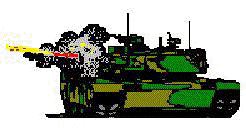
The soldier is conditioned to the possibility
of this peril in the structure of the military itself, in which the soldier
loses his individuality during the process of his training and indoctrination.
His body disappears in the uniformity of military dress, which foreshadows
the dissolution of the body in the unidirectionality of speed. As the habits
and disciplines of military life ingrain themselves into a soldier's being,
so the machinic assemblage of the main battle tank overgrafts the man,
and his organic body disappears in the superpower of a metallic body that
annihilates the limits of time and space in its destruction of the earth.
Therefore, when man drives the tank and fires the projectile, he is also
driven, he is also propelled through time and space. And, in the absolute
offense that is engendered by modern mobile land warfare, man moves from
the liberation of movement to the tyranny of speed.
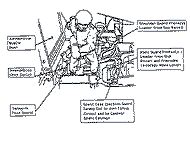 The
motor and the tread, in their continuous inexorable movement, simulate
the wakefulness of human consciousness. But these devices far outrange
any cognitive capability that is supported by mere organic metabolism,
and the eternal offensive movement they engender soon subsume the man that
once controlled them. The life of the cyborg, once measured by the soldier's
pulse, is now assessed by the speedometer of the racing engine. The
motor and the tread, in their continuous inexorable movement, simulate
the wakefulness of human consciousness. But these devices far outrange
any cognitive capability that is supported by mere organic metabolism,
and the eternal offensive movement they engender soon subsume the man that
once controlled them. The life of the cyborg, once measured by the soldier's
pulse, is now assessed by the speedometer of the racing engine.
The M1A1 main battle tank is therefore a triumph
in the field of human engineering in every respect. It incorporates some
of the most sophisticated ergonomics into its system, to ensure maximum
comfort (and efficiency) of the crewmen within. It tears over the obstacles
of the earth, crossing rivers , negotiating mountainous terrain and overrunning
vegetation in its quest to subordinate the earth, the matrix, to human
standards of rationality. It is engineered to be the superior machinic
matrix for its crew members, enclosing them in womblike spaces and sheltering
them in the haven of its armor protection, and can be upgraded and retrofitted
with the latest technological innovations to keep up with any improvements
that potential enemy forces make to their own vehicles. It even conditions
the human crew members to its needs, for they make their decisions to engage
enemy vehicles based on the tank's ability to accurately and efficiently
destroy those targets.

And when the human operators can no longer keep
pace with the machine's requirement, another piece of machinery takes his
place. In many proposed replacements for the M1 series of vehicles, the
human loader is replaced with an automatic loader, because the human can
no longer keep up with the rate of fire that the main battle tanks of other
nations require for optimum performance on the battlefield. The increased
efficiency of technology has become the standard by which soldiers, human
beings, are assessed. The machinic complement of the construct of the cyborg
has subverted the primacy of the human being, engineering the human to
its standard, confounding those that had sought to appropriate it for their
own ends.
Note: The use of themasculine pronoun is deliberate,
since in the U.S. Army, women are not currently permitted to serve as crew
members of most combat vehicles. This does not mean that women do not perform
tasks in areas on the battlefield that expose them to enemy fire; only
that they cannnot fire back as effectively.
NOte
Works Cited
|